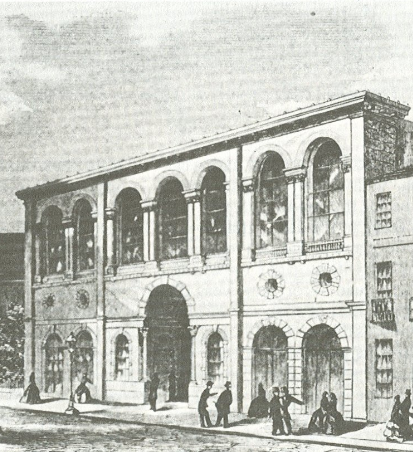SOUTH CAROLINA SECESSION HALL
1852 - 1861
This essay is adapted from Lost Charleston. We visit the site of the S.C. Institute Hall on our Lost Charleston tours.
The very fabric of the United States of America was torn asunder on the evening of December 20, 1860, when the Ordinance of Secession was signed at S.C. Institute Hall. The Charleston Mercury noted that news of South Carolina’s secession from the Union “spread through the city like wild-fire.” Prophetic words indeed.
The S.C. Institute for the Promotion of Art, Mechanical Ingenuity, and Industry was founded in 1849 to promote “art, ingenuity, mechanical skill, and industry.” Its annual fairs showcased locally manufactured goods so successfully that the S.C. Legislature appropriated $10,000 in 1852 to build a new hall for the Institute.
Charleston’s leading antebellum architectural duo, Edward Jones (1822-1902) and Francis Lee (1826-1885) oversaw its design and construction. Jones and Lee are credited with bringing romanticism to Charleston’s architectural spectrum and Institute Hall was among their most impressive projects. Completed in the Italianate style in 1854, Charleston’s largest venue seated 3,000 and hosted a variety of exhibits. Yet it was the Democratic Convention of 1860 that sealed its place in history.
Democratic delegates from across the nation began arriving at Institute Hall in April 1860 to select their party’s presidential candidate. Within days the contentious convention split into Northern and Southern factions and disbanded. It later reconvened in Baltimore, where Stephen Douglas was marginally nominated to represent the Democrats.
When news of Abraham Lincoln’s election reached Charleston on November 7, a large pro-secession rally was held at the Hall. The fervor was tangible as prominent Charlestonians, one after another, delivered fiery speeches calling for secession. On December 17, some 160 delegates convened in the state’s capital, Columbia, to decide whether to withdraw from the Union. A smallpox outbreak caused the delegates to relocate to St. Andrews Hall in Charleston for their deliberations where, on December 20, their unanimous vote sealed South Carolina’s fate. The Ordinance was drawn up and delegates gathered before a huge, cheering crowd at Institute Hall to sign the document. The die was cast, the nation split.
Church bells rang, artillery salutes thundered, and giddy volunteers donned military uniforms, according to the Charleston Mercury. The flamboyant scene is said to have inspired Charleston’s most celebrated jurist and Unionist James L. Petigru to exclaim, “South Carolina is too small for a Republic and too big for an insane asylum.”
Unfortunately, news of secession wasn’t the only wildfire to spread through Institute Hall. On December 11, 1861, the largest of Charleston’s great fires roared down Meeting Street. Robert E. Lee, a guest at the Mills House Hotel across the street, watched as Institute Hall, along with the Circular Church, disappeared into the flames. It was never rebuilt.




